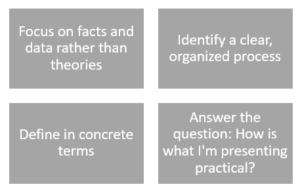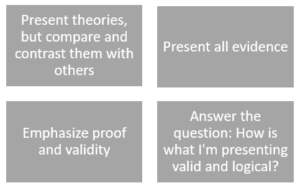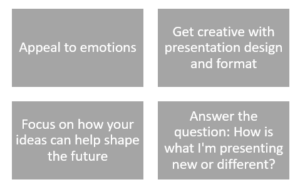When it came time to study for a test, my daughter Eleanor liked to sit alone at the computer and design PowerPoint presentations to help her learn and recall information. My daughter Clara liked to have someone else quiz her while she walked around the dining room table. Just like my two daughters, we all learn in different ways.
For those of us who are speakers, we need to be reminded of this often. It’s easy to fall into a pattern of presenting. Perhaps we present in the way we like to learn. Or we follow what we’ve seen modeled. But as teaching technologies continue to advance and cognitive research tells us more about the inner workings of our brains, it’s important to adapt and approach presentations with increased variety and ingenuity.
On Monday we talked about the classic learning styles: auditory, visual, and kinesthetic. Today, we’ll look at the four styles of learning developed and researched by Harvey Silver and his colleagues. We’ll define each learning style and give a few ideas for how to develop content that appeals to each style.
The Mastery Style Learner
“Absorbs information concretely; processes information sequentially, in a step-by-step manner; and judges the value of learning in terms of its clarity and practicality.”
A mastery style learner appreciates details that are arranged in a clear pattern of progression. This type of learner isn’t interested in “head in the clouds” type theories and would rather you build a solid foundation of how the information you are presenting is practical and applicable to the real world. These learners appreciate chronological or sequential designs.
Presenting to a mastery style learner:
The Understanding Style Learner
“Focuses more on ideas and abstractions; learns through a process of questioning, reasoning, and testing; and evaluates learning by standards of logic and the use of evidence.”
An understanding style learner needs to weigh all the options before finding the one they believe. You might have this learning style if you’ve been called a devil’s advocate. For this type of learner, it’s all about testing and proving.
Presenting to an understanding style learner:
The Self-Expressive Style Learner
“Looks for images implied in learning; uses feelings and emotions to construct new ideas and products; and judges the learning process according to its originality, aesthetics, and capacity to surprise or delight.”
The self-expressive style learner is a creative innovator. These learners might be called “dreamers.” They look for ways to think outside the box and to forge new paths and connections between what is and what could be.
Presenting to a self-expressive style learner:
The Interpersonal Style Learner
“Focuses on concrete, palpable information; prefers to learn socially; and judges learning in terms of its potential use in helping others.”
For the interpersonal style learner, everything boils down to relationships. They are focused on how information influences and advances the human race. Interpersonal style learners will enjoy presentations that are interactive.
Presenting to an interpersonal style learner:

As you seek to develop presentations that appeal to all learning styles, use the following statistics to guide you. Silver and Strong found that about 70% of learners are divided between mastery and interpersonal styles. If you develop content that speaks primarily to these styles, you’ll resonate with the majority of your audience members. But don’t forget about the self-expressive and understanding style learners. Seek to develop content with variety so that you can reach all audience members, no matter their learning style.

Scientific research is the foundation of our presentation design and training at Ethos3. Ready to learn more?


